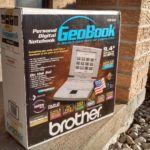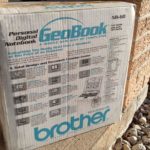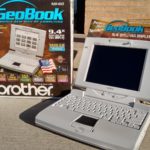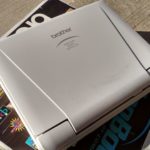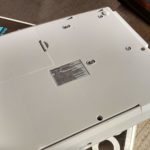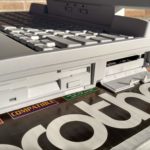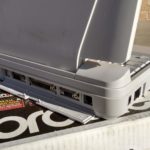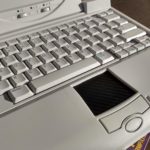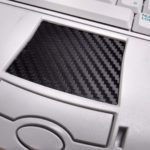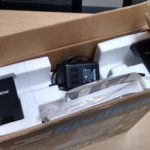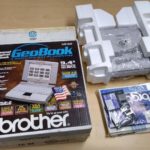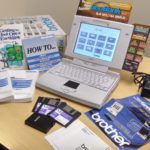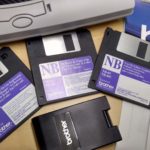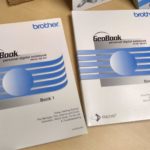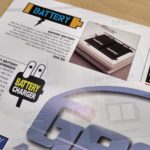The GeoBook NB60 – A unique little laptop introduced in the late 1990’s to provide a low-cost alternative to the rising popularity in laptop computers. During this time, an average laptop computer would set you back anywhere from $2-$5k, far too much for the average home user or student to justify. This left a space in the market for ultra budget laptop computers, for those consumers who were not sure how useful a more expensive laptop would be, or for those who simply needed a cheap word-processor for school or personal use.
The GeoBook appears to have mostly been a flop, considering info on these is very sparse. I was lucky enough to find a GeoBook NB60 new in box on ebay for a reasonable price, which included all original software and documentation. We’ll take a look at the original packaging, manuals, etc, followed by an overview and demonstration of the GeoBook. I’ll probably upload images of the disks in the name of preservation, along with any of the custom tweaks I make to the laptop, and we’ll see what it was like using this strange little laptop computer.
Unboxing
Brother packed quite a lot in this little box. The first thing I found odd was the included promotional cutout you could stick to the laptop. I guess they were really pushing for retailers to put these on display. Everything was boxed quite securely, and they sure did include a lot in the box. There are multiple manuals, quick start guides, diskettes, and order forms for accessories such as additional batteries, chargers, or memory expansions.
Overview
The Geobook is a very plain looking, very chunky beige laptop. Considering how much empty space is inside this, I assume they made it larger for ease of assembly, and to make it look more similar to its higher cost competitors. In fact, just by removing the keyboard, you can see basically the entirety of the inside. It has a fairly small motherboard, two battery packs, and a standard desktop floppy drive. The display is a monochrome backlit passive matrix panel, which isn’t great by any means, but for the tasks it was built for, it’s good enough. The hinges are… eh, not great. In fact, the way the display cable is routed is a huge problem with these units. After only a handful of times opening it, the flat-flex cable started to crack, causing a loss of display. I could have bought a newer flat-flex cable to replace it, but opted to replace it with my own wiring harness using a salvaged VGA cable. This actually improved the video quality as well on my unit. The keyboard is pretty decent. It’s probably one of the better aspects of the GeoBook, which is a smart move considering word processing is the most likely usage of this computer. The trackpad is absolutely terrible, as were most 90’s trackpads, but it gets the job done. The rubber coating on mine was cracked and peeling, so I removed it and replaced it with a faux carbon fiber vinyl sheet, which feels much nicer to use. The side features a PCMCIA slot, though I’ve never been able to get any flash cards to work with it. I believe it uses Linear flash instead of ATA flash, so cards are a little more difficult to come by, and a compact flash adapter would not work.
Specifications
The GeoBook was not a powerhouse by any means, even by 1998’s standards. To cut costs, the GeoBook used system on a chip technology, a technology still used today by small electronics such as smartphones and tablets. Instead of having a separate Processor, Chipset, and Graphics, all these functions are combined into one single package. The main system chip, the AMD Elan SC300, features a 386sx processor at 33mhz, and integrates a memory controller, DMA controllers, interrupt controllers, real-time clock, serial and parallel ports, and PCMCIA slots. It seems these chipsets were intended more for industrial applications. Things like system boards for industrial machinery, or terminals for basic controls. The system I have, the NB60, has only 4mb of system memory, and a 1MB of flash storage. The OS is permanently installed in ROM, and cannot be modified.
Operating System
This sort of hardware configuration is nowhere near enough to run Windows, but the GeoBook had a few tricks up its sleeve. Instead of using Windows, the GeoBook runs an alternative operating system called GEOS, a graphical interface which sits on top of DOS. The GEOS operating system is one of the reasons I find the GeoBook such an interesting device, and I’ve made a few modifications to the system to bring back functionality not found in the original product. Normally, the system boots up to a simple Brother branded landing screen, which can launch any of the built-in applications one at a time in fullscreen. In fact, the default configuration resembles more of a pocket organizer style interface, instead of a full blown OS of the day. However, by adding an alternative configuration file in Flash memory, the system reads this instead of the built-in configuration file, allowing me to change the default shell. The default shell boots up slower, but allows me to run multiple applications at once, fullscreen or windowed. I can also add additional programs to the launcher.
The system runs a version of DOS called Datalight ROM DOS. In theory, this expands the capabilities of the machine greatly by allowing MS-DOS compatibility. In practice though, many programs I’ve tried, especially games, simply do not work correctly or crash the machine. One particular bug I have not been able to get around involves the keyboard. It appears that the system uses some sort of nonstandard keyboard, because most games I’ve tried do not correctly respond to keypresses. I’ll occasionally get some keys to register, but they often repeat or do strange things when they do register. This means that almost any games I’ve tried were entirely unplayable due to the lack of controls, which is disappointing, as a tiny 386 machine would have been great for some of the more simple DOS era games, without having to setup a desktop.
Programs
I actually kind of love the GEOS interface. It’s very simple, and reminds me of Windows 3.1 . In fact, the system could very easily be mistaken for Windows 3.1. It uses a similar launcher, and minimizes programs to icons on the desktop. While there are not nearly as many applications available, the ones that are included are actually quite useful. The Office suite is extremely capable, with a wonderfully intuitive interface to anyone who has ever used Microsoft Word. Likewise, the spreadsheet and drawing programs are also very capable. If it were easier to transfer files to modern machines, I could see myself using this as a distraction free computer for word processing, even today.
Instead of trying to get DOS programs working, I went on the hunt for more GEOS programs. There seems to be a small following of PC-GEOS fans, and I did find a few addon and homebrew applications. One of the more useful addon programs is a simple Terminal emulator. It has a few options for line count, terminal type, etc, and I’ve been able to do fun things like connect to Cisco routers for programming and such. I can even connect to my Raspberry Pi Zero, which gives me full linux shell.
Internet
I wanted to try to connect the GeoBook to the internet, and see if I could use it for anything remotely useful. Of course, I’m not going to use this as a daily driver, but I figured it would be fun to try. I ended up using a Raspberry Pi Zero W to act as the bridge between the GeoBook and the outside world. Of course, I can simply use the serial terminal to directly login to the raspberry pi, allowing me to use it as a tiny linux machine, and while this is definitely the most useful method as I get a full Linux capable machine, it’s sort of cheating, as the Geobook really isn’t doing a whole lot of work acting as a dumb terminal.
I can also setup the Raspberry Pi to emulate a modem. In this mode, the Raspberry Pi emulates a standard serial modem, and parses phone numbers as IP addresses. This allows me to use the serial terminal to “dial” a BBS through a telnet connection. This feels a lot more like something which could have been done when the GeoBook was new, using a modem to dialup to a BBS, though it’s still not using the Geobook to its full potential.
Luckily, the GeoBook also supports dialup PPP connections. I can setup the Raspberry Pi to intercept a certain phone number, and form a PPP connection with the GeoBook. To the Geobook, it looks like it’s using a standard serial modem to login to an ISP, while the Raspberry Pi routes all internet traffic over WiFi. This allows me to truly experience what could be done on the GeoBook back in the day. With this method, I can very, very slowly load websites with the built-in web browser… I can connect to an Email server… and I can even use an IRC client! Unfortunately, most email servers will not be supported, as it cannot use modern encryption methods, and nobody uses IRC anymore. But hey, we got it working!
Conclusion
Well, even though it’s absolutely the most useless machine in my collection, I still love it. It’s not particularly useful nowadays, and I can’t even really play games on it, but it’s just such a weird little machine that it stands out as one of my favorites. It has specifications that were 10 years out of date when it was released, it’s cheaply made, and it’s ugly as all heck, but the fact that it exists and tried to put computing into the hands of more people is admirable. I’d like to eventually move the raspberry pi into the actual computer, so I don’t have to power it externally, though maybe I’ll just keep it as-is. I think it would be pretty funny to bring it somewhere like a starbucks and fire up SSH to work on my webservers or write future scripts on it. If you have any questions or comments about this odd little machine, please let me know, and check out my YouTube channel!
